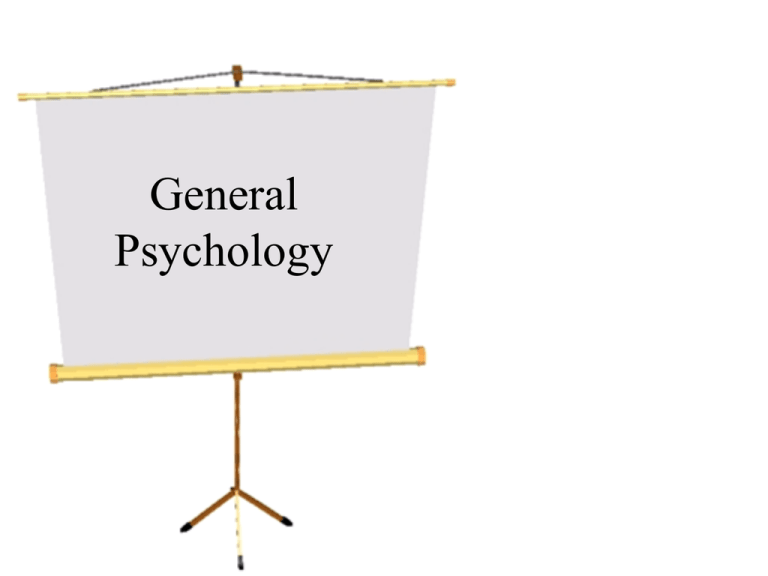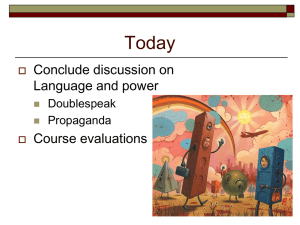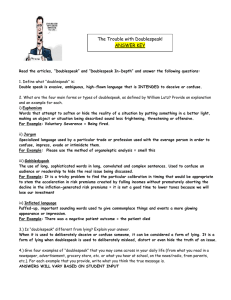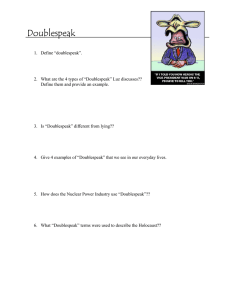months - K-Dub
advertisement

General Psychology Scripture • James 1:23-25 Anyone who listens to the word but does not do what it says is like a man who looks at his face in a mirror and, after looking at himself, goes away and immediately forgets what he looks like. But the man who looks intently into the perfect law that gives freedom, and continues to do this, not forgetting what he has heard, but doing it--he will be blessed in what he does. Uses of Language We can hear about and understand phenomena we have never experienced. We can connect to people far away. We can make plans and have others carry them out. We can know what another person is thinking more directly than just by observing their behavior. We can store information. What is language made of? Phonemes are the smallest units of sound (vowels and consonants). Morphemes are the units of meaning, i.e. words and meaningful parts of words such as suffixes, prefixes). Grammar refers to the rules for using words, including semantics, definitions, connotations, and syntax (how the order of words makes meaning). How do we learn language? Language Development Language Development is an Amazing Process We acquire the use of 10 new words per day (on average) between ages 2 and 18. Children learn the basic grammar of language before they can add 2 + 2. Most kids can recall words and meanings, and assemble words into sentences, while simultaneously following social rules for speaking and listening. abbreviate absorbent accept access accessible accessory acoustics accumulate adjust aerial affects alien allotment allotted already altercation amass amendment amorous ancestor anecdote angular anonymous antidote antique How do we learn language? Language Talents and Stages Age (months) Talent/Behavior/Stage 0-4 months Receptive language: associating sounds with facial In fantis movements, and recognizing when sounds are broken (“not speaking”) into words 4 months Productive language: babbling in multilingual sounds and gestures 10 months Babbling sounds more like the parents’/household’s language 12 months One-word stage: understanding and beginning to say many nouns “telegraphic”/tweet speech: adding verbs, 18-24 months Two-word, and making sentences but missing words (“See bird! Ree book? Go park!”) 24+ months, 2+ years Speaking full sentences and understanding complex sentences Explaining Language Acquisition: Nature and Nurture The Role of Genes We seem to have an inborn (genetic) talent for acquiring language, though no particular kind of language is in the genes. The Role of Experience We also seem to have a “statistical” pattern recognition talent. Infants quickly recognize patterns in syllable frequency and sequence, preparing them to later learn words and syntax. Critical Periods According to one study with immigrants, beginning a language later made it harder to learn the pronunciation and the grammar of the second language. It is important to begin appropriate language exposure/education early so that language centers of the brain continue to develop. Language might never develop if not begun by age seven. Deaf and Blind Children Deaf and blind children can use complex adapted languages by using other senses that are heightened. Sign language has the syntax, grammar, and complex meaning of any spoken language. “Blindness cuts people off from things; deafness cuts people off from people.”—Helen Keller What happens if a deaf infant’s parents don’t use sign language? Hint: critical period Brain Damage and Language Aphasia: an impairment in the ability to produce or understand language, usually caused by damage to the brain Broca’s area, in the left temporal lobe Damage to Broca’s area leads to difficulty in putting words together in sentences or even speaking single words, although a person can sing a song. Examples of aphasia: having the ability to speak but not read, to produce words in song but not in conversation, and to speak but not repeat; or producing words in jumbled order Wernicke’s area, left temporal lobe Damage to Wernicke’s area leads to difficulty comprehending speech and producing coherent speech (not easily monitoring one’s own speech to make sure it makes sense). Language and the Brain How to read a word, steps 1 to 5 Remember: language functions are divided in the brain. Thinking and Language, Language and Thinking How does our style of thinking shape our use of language? How does language shape the way we think? Can we think without language by using images? Language Influencing Thought Linguistic determinism: the idea that our specific language determines how we think For example, Benjamin Whorf (1897-1941) proposed that because the Hopi do not have past tense forms for verbs, it is hard for them to think about the past. Can you think about something that you do not have a name for? If so, does that disprove linguistic determinism? Language’s Influence on Thought Does language shape emotions or reflect them? Speaking in Japanese provides many extra words for interpersonal emotions such as sympathy and empathy, which Americans might have trouble differentiating. Speaking English gives us many words for self-focused emotions, such as sadness. Do language differences shape personality differences? Bilingual people appear to have different personality profiles when describing themselves in different languages. “Learn a new language and get a new soul.”--Czech proverb. Color Perception We use our native language to classify and to remember colors. Different languages may vary in where they put the separation between “blue” and “green,” or they may not have separate words for these colors. Which squares are green? teal? blue? Language Influences Thought Gender neutral vs. male-based usage Even if “he” and “mankind” are meant at times to be genderinclusive, people do create a male image in their mind when they hear these terms. Instead of replacing “he” with “he/she” or “their”, we can rewrite sentences without pronouns and possessives; for example, “his” can become “the.” Languages Improve Thinking The Bilingual Advantage People who are bilingual have numerous brain connections and neural networks. They also have a hidden talent, the ability to suppress one language while learning another. This ability tends to go along with other forms of executive control, such as resisting distraction and inhibiting impulses. Thinking in Images Without Words Is there conscious thinking that goes on without being formed as words? Some everyday decisions, such as which turn to take while driving, are certainly made based on images or other nonverbal content such as mental maps. Using Imagery to Improve Learning Image rehearsal can help us improve behavior, even skilled performance such as playing piano or playing sports. If you imagine getting an A (outcome simulation), it may shift your mood up or down but will not improve your grade. Imagining the detailed actions of studying (process simulation), though, does improve grades. Think about the road, not the destination. Conclusions Thinking affects our language, which then affects our thought. 1.Thinking in a culture affects the formation of a language, especially its vocabulary. 2.Thinking and language develop together in an individual as they grow. 3.Learning a language and using a language as an adult can affect one’s style and content of thinking. Mental Models • • • Imagine the letter D. Rotate it 90 degrees to the right. Put the number 4 above it. Now remove the horizontal segment of the 4 to the right of the vertical line. Imagine the letter B. Rotate it 90 degrees to the left. Put a triangle directly below it having the same width and pointing down. Remove the horizontal line. Imagine the letter K. Place a square next to it on the left side. Put a circle inside the square. Now rotate the figure 90 degrees to the left. Mental Models • • • sailboat Valentine television Doublespeak 1. revenue enhancement = tax increase 2. inoperative statements = 3. social expression products = 4. poorly buffered precipitation = 5. media courier = 6. oral hygiene appliance = 7. negative patient care outcome = 8. vertical transportation corps = 9. period of accelerated negative growth = 10. radiation enhancement device = 11. automotive internist = 12. pre-emptive counterattacks = 13. pupil station = 14. underground condominium = 15. digital fever computer = Doublespeak 1. revenue enhancement = tax increase 2. inoperative statements = Lies 3. social expression products = greeting cards 4. poorly buffered precipitation = acid rain 5. media courier =newspaper carrier 6. oral hygiene appliance = Toothbrush 7. negative patient care outcome =Death 8. vertical transportation corps = elevator operators 9. period of accelerated negative growth =Recession 10. radiation enhancement device =neutron bomb 11. automotive internist =car mechanic 12. pre-emptive counterattacks = first-strike, or invasion; 13. pupil station =school desk 14. underground condominium =cemetery plot 15. digital fever computer =thermometer. Doublespeak • • • Euphemism, an inoffensive or positive word or phrase used to avoid a harsh, unpleasant, or distasteful reality. Jargon is a second kind of doublespeak. It is the specialized language of a trade or a profession, such as medicine, law, engineering, education, or auto mechanics. Gobbledygook or bureaucratese is a third form of doublespeak. This is simply a matter of piling on words, or overwhelming the audience with long sentences. – As a vice-presidential candidate, Dan Quayle explained the need for a “strategic defense initiative” by saying, “why wouldn’t an enhanced deterrent, a more stable peace, provide a better prospect to denying the ones who enter conflict in the first place to have a reduction of offensive systems and an introduction to defensive capability? I believe this is the route the country will eventually go.” • The fourth kind of doublespeak is inflated language that attempts to make the ordinary seem extraordinary, to make everyday things seem impressive, to make the simple complex.








